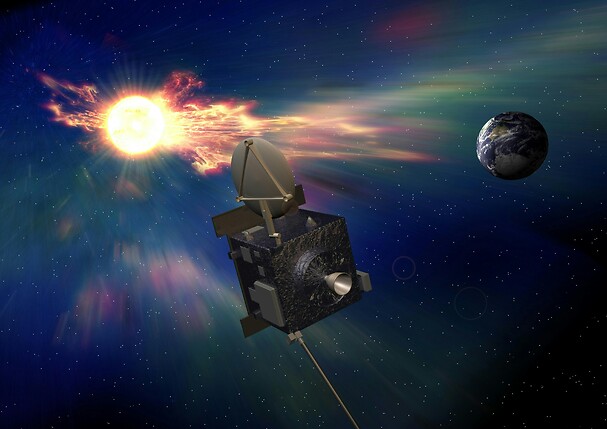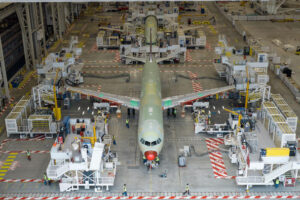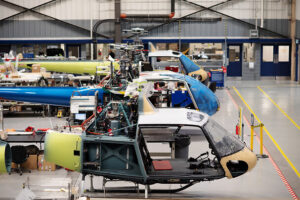
Weather isn’t just an Earthly concern; it also plays a role in space. To improve forecasting, Airbus is designing and building the satellite for ESA’s space weather mission Vigil. But what is space weather and why is it important?
When we think of weather, we usually think of sun, rain and snow. But did you know that there is a form of weather that extends far beyond the Earth? In fact, space has its own dynamic and often unpredictable weather, driven by the Sun.
To improve our ability to forecast and mitigate its effects, the European Space Agency (ESA) is preparing Vigil—the first dedicated space weather monitoring satellite positioned at the Sun-Earth L5 Lagrange point.
Designed, developed, and built by Airbus Defence and Space in Stevenage, UK, the Vigil satellite will be positioned at a unique vantage point to observe solar activity before it impacts Earth, offering crucial early warnings.
But why does space weather matter, and how will Vigil help? We let Dr. Alexi Glover explain. As Space Weather Service Coordinator at ESA’s Space Weather Office, she is no stranger to the subject: “Our job at the Space Weather Office is to develop, test, and demonstrate European capabilities to monitor space weather conditions and predict when a major event is likely to impact Earth, giving enough time to react and prepare.”
What is space weather?
Space weather refers to the changing conditions in space caused by the Sun’s activity, particularly the solar wind, solar flares, and coronal mass ejections. These phenomena release vast amounts of charged particles and magnetic energy into space, which can travel toward Earth and interact with our planet’s magnetic field. During intense space weather events, these interactions can disrupt satellites, power grids, and communication systems while also posing radiation hazards to astronauts.
Trailing Earth and monitoring the sun: In the future, the Vigil spacecraft will keep a close eye on solar activity and warn us of incoming space weather events. ©ESA
How does a space weather event come about? The Sun goes through periods of high and low magnetic activity, known as the solar cycle, which lasts around 11 years. During peak solar activity, the likelihood of major space weather events increases. Understanding these cycles is essential for predicting the severity and frequency of solar storms.
Why does space weather matter?
Our modern world relies heavily on space-based technology, making it vulnerable to space weather events. Disruptions to GPS and communication networks can impact aviation, maritime navigation, and emergency response systems. Power outages may occur due to geomagnetically induced currents overwhelming electrical grids, leading to costly damage and blackouts. Satellites—critical for weather forecasting, telecommunications, and scientific research—are also at risk, as high-energy particles can damage their electronics.
Additionally, astronauts, particularly those on deep-space missions, are exposed to elevated radiation levels during space weather events, highlighting the need for improved forecasting and protection strategies.
Space weather can affect us on Earth in a variety of ways. ©ESA
Geomagnetic storms, caused by interactions between coronal mass ejections and Earth’s magnetic field, can have widespread effects. These large-scale disturbances in the Earth’s magnetosphere often trigger phenomena such as the aurora borealis. While beautiful to observe, these storms can cause significant disruptions to power grids, satellite operations, and navigation systems.
A major solar storm, like the 1859 Carrington Event, which created auroras as far south as the Caribbean and disrupted telegraph systems worldwide, could have catastrophic consequences today, making reliable space weather forecasting essential. Lloyd’s insurance company published a systemic risk scenario indicating that the global economy could face losses of $2.4 trillion over a five-year period due to a hypothetical extreme solar event.
How will Vigil improve space weather forecasting?
Current space weather monitoring primarily relies on Earth-oriented observations, including satellites in Earth orbit and at the L1 Lagrange point, which is positioned between the Sun and Earth. However, these satellites detect solar activity only once they are already directed toward Earth, providing limited advance warning.
There are five Lagrange points, where the gravitational forces of the Sun and the Earth cancel each other out. Vigil will occupy a unique position at the fifth Lagrange point (L5). ©ESA
Vigil will enhance this approach by being stationed at the L5 Lagrange point—60 degrees behind Earth in its orbit. This unique position allows Vigil to observe solar activity ‘from the side’, providing an early look at active regions on the Sun before they rotate into Earth’s direct view. Vigil will track the Sun’s activity, monitor the development of coronal mass ejections, and analyse solar wind structures before they reach Earth. All of this will help give early warning of potentially disruptive space weather events.
A new era of space weather monitoring
With our critical infrastructure susceptible to space weather events and humanity increasing its activities in space, understanding and predicting space weather is more important than ever. By combining Vigil’s L5 observations with data from Earth-orientated missions, scientists will get a more complete picture of solar activity, leading to more accurate and timely warnings for industry and governments worldwide.






